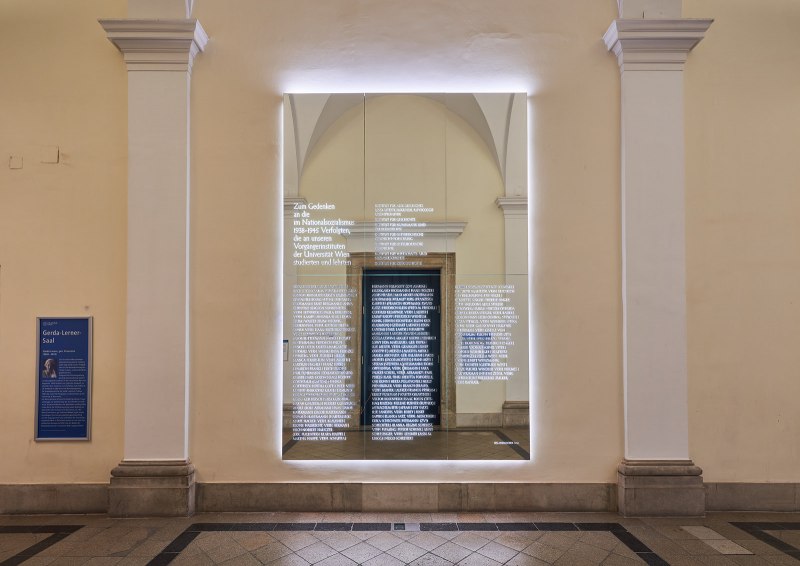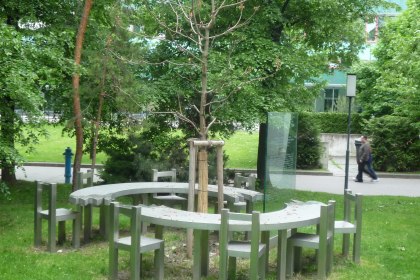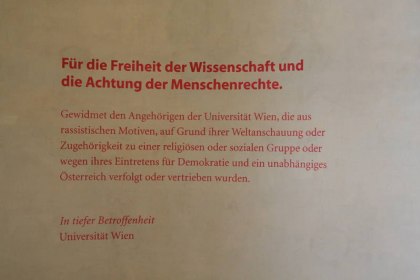Monument “Expelled Historians”
On May 19, 2022, the opening of "When Names Shine. Memorial to the History Students and Teachers of the University of Vienna Expelled under National Socialism" by Vice Rector Regina Hitzenberger and Dean Sebastian Schütze in the presence of the Ambassador of the State of Israel, Mordechai Rodgold, took place (download folder).
Intention/Historical Background
The strong anti-democratic and anti-Semitic sentiment at the University of Vienna in the 1920s and 1930s and the active role of the university in the expulsion of a large number of its teachers and students during National Socialism 1938-1945 as well as its reappraisal in recent decades form the background of this memorial initiative.
After the so-called "Anschluss" to the "Third Reich" in March 1938, around 3,000 mainly Jewish members of the University of Vienna were dismissed, expelled and/or murdered - teachers, students and administrative staff. Well over 100 people from the History Department were also affected.
A project group led by Martina Fuchs and consisting of representatives of today's historical departments of the University of Vienna (Department of Ancient History and Classical Studies, Papyrology and Epigraphy, Department of History, Department of Numismatics and Money History, Department of Austrian Historical Research, Department of Eastern European History, Department of Economic and Social History, Department of Contemporary History) wants to face their history, to remember this injustice and is at the same time aware of the university's co-responsibility for this inconceivable suffering, which was also inflicted on members of the University of Vienna at that time. The names and biographies of the dismissed, expelled and disenfranchised women and men who were affected at the historical department of the time were researched by the "Forum Zeitgeschichte der Universität Wien" (Forum for Contemporary History of the University of Vienna) and will be commemorated on the memorial not only collectively, but individually, by name ("Give names to memory", Saul Friedländer). Building on the preliminary work within the framework of the "Memorial Book for the Victims of National Socialism at the University of Vienna 1938" (2009), the names of the students and teachers will be mentioned on this memorial for the first time - their names and biographies will become part of the collective memory and remembrance space of today's university, of today's history students and teachers. As new information becomes available, the memorial will be expanded accordingly
"The findings of the cultural scientist Aleida Assmann also apply to the university in particular: it is not forgetting that becomes the motor of renewal, but remembering, if it also proves to be the basis for a new self-image. (Gerade auch für die Universität gilt der Befund der Kulturwissenschaftlerin Aleida Assmann: Nicht das Vergessen, sondern das Erinnern wird zum Motor der Erneuerung, wenn es sich zugleich als Basis für das neue Selbstbild erweist)"
(Rector Heinz W. Engl, Dies academicus, 12. März 2021)
Place/Situation
The monument is located at the "history hallway (Historiker*innen-Gang)" in the main building of the University of Vienna - on the 1st floor, next to lecture hall 41 (Gerda Lerner Lecture Hall since June 2022). The place is then as now a center of history studies: several of the historical departments are accessed from here; the lecture hall behind the memorial is a central teaching and learning place, especially for history students. For the present and the future, this memorial is intended as a rememberance and at the same time as a reminder to the members of today's university: "Resist the beginnings! (Wehret den Anfängen)"!
The biographies of all expelled students and teachers commemorated on the memorial have been incorporated into the online Memorial Book for the Victims of National Socialism at the University of Vienna 1938, supplemented by documents and photographs.
Names
Osias Heschel Babad (1899–1984) | Jakob Josef Bachstitz (Yaakov Bahat) (1910–1988) | Chiel Juda Bahrer (1903–1941) | Bernhard Eugen Baumgarten (Yissacher Boimgarten) (1919–1988) | Johanna Bechmann (1895–1981) | Kurt Bergmann (1919–2003) | Anna Christine Bergson-Sonnenberg, m. Lethbridge (1918–2007) | Paula Bergstein, m. Kampf (1915–1996) | Jehosua Blau (1919–2020) | Dora Blum (1910–1944) | Walter Blum (1919–1998) | Hedwig Bodenstein, m. Leitner (1916–1994) | Berta Bondi, m. Haag (1916–2008) | Ruth Buchbinder, m. Kleinberg (1919–2005) | Josef Burg (1912–2009) | Jakob Buttermann (1908–1941) | Otto Chomet Kestenbaum (1914–1955) | Friedrich Engel-Jánosi (1893–1978) | Felix Fanto (1910–1991) | Margarete Feldbau, m. Shenk (1915–2005) | Rosa Feriszke Leimberg, m. Jelinek (1914–?) | Stella Blanca Feuerstein, m. Arditti (1914–1993) | Gertrud Fischer (1911–?) | Franz Forel (1911–1972) | Elisabeth Frankl (1915–?) | Edith Fuchs (1919–?) | Paul Fuhrmann (1915–?) | Eduard (Edward) Glaser (1918–1972) | Saul Goldschlag (1891–1987) | Herbert Goldstaub (Galton) (1917–2004) | Penina Gottfried (1897–1942) | Hertha Gottscheer, m. Kessler (1910–2012) | Innozenz Grafe (1916–1992) | Edmund Groag (1873–1945) | Berisch Gross (1906–1991) | Paula Eugenie Gross, née. Hirsch (1909–1998) | Sara Günsberg (Sarah Ginzberg) (1900–?) | Herbert Günzburg (1914–1994) | Adolf (Rolf Abraham) Haas (1917–1999) | Jakob Habermann (Jacob Haberman) (1912–1975) | Oswald Habermann (Haberman) (1915–1997) | Marie Hacker, m. Klausner (1914–?) | Regine Halbrecht, m. Berman (1915–2008) | Erich Norbert Haliczer (Eric Hallister) (1915–1956) | Klara Haspel (1914–?) | Martha Hauer, m. Schapira (1914–1997) | Hermann Helfgott (Zvi Asaria) (1913–2002) | Hildegard Hickmann (1917–?) | Hans Holzer (1920–2009) | Alois Hradil (1915–1981) | Max Moses Jägermann (Jagerman) (1915–2012) | Helmut Jörg (1913–1943) | Franziska Karpeles (Frances Hoffman) (1915–1997) | David Katz (1914–?) | Friedrich Klein (Fred M. Friedel) (1915–2006) | Gertrud Klempner, m. Laubier (1915–1999) | Emmy Knopf (1917–1942) | Friedrich Wilhelm König (1897–1972) | Erwin Kronfeld (1914–1939) | Egon Kux (Kadmon) (1913–1993) | Gerhart Ladner (1905–1993) | Leon Landau (1911–?) | Paul Lande (1916–1999) | Elisabeth Marianne Langer (1912–1986) | David Lanner (1908–1986) | Gisela Lewin (1913–?) | August Loehr (1882–1965) | Heinrich Löwy (1908–?) Ida Margulies, née Piepes (1910–2003) Ilse Meiler, m. Grainger (1918–?) | Josef (Joseph F.) Meisels (1911–2001) | Martha Meisl (1920–2014) | Malka Michaeli, née Balaban (1913–1994) | Jakob Mörsel (Jacob Moersel) (1915–?) | Hans Mžik (1876–1961) | Stefan (Stephen A.) Neumann (1917–1971) | Doris Oppenheim, m. Liffmann (1919–?) | Sara Pauker Scherl, m. Abramsky (1915–1995) | Emil Perels (1880–1944) | Karl Pink (1884–1965) | Melitta Pohorille, née. Kohn (1893–about 1959) | Herta Polatschek (1908–1973) | Nelly Pressburger, m. Brasch (Brash), m. Mandl (1913–1972) | Alfred Francis Přibram (1859–1942) | Ernst Pulgram (1915–2005) | Walter Quartner (1917–2001) | Viktor Rosenfeld (1908–?) | Isaac Rosin (Yits-Haq Rozen) (1913–?) | Helene Rübner (Rubner) (1917–2011) | Menachem Beir Şafran (1913–?) | Lily Salz (1915–1996) | Ilse Sanders, m. Robey (1914–2001) | Josef Sapiro (1919–?) | Blanka Satz, m. Moscisker (1917–2009) | Erika Schechner (1916–?) | Hermann (Zvi) Schechter (1915–1995) | Blanka Regine Schelest, m. Stanley, m. Fleming (1915–1995) | Isidor Schenk (1904–?) | Anny Schlesinger, m. Lessner (Ann M. Lingg) (1907–1995) | Hugo Schreiber (1913–?) | Herbert Schwarcz (1917–?) | Ernst Schwarz (1916–2003) | Elisabeth Sgalitzer, m. Elizabeth S.-Ettinghausen (1918–2016) | Lily Siegel (1918–?) | Henriette Singer, m. Guenther (1916–1996) | Therese Singer, m. Sheldon (1917–1988) | Alice Sperber Bernzweig (1916–?) | Julius Spritzer (Yehuda Reshef) (1920–?) | Herta Steiger, m. Rader (1914–?) | Gideon Hans Stein (John G. Stewart) (1918–2010) | Klara Stengel, m. Weinberg (1912–2008) | Erika Stern, m. Galinovsky (1917–1996) | Eugenie Steuerman, m. Giselle von Grunebaum (1917–2001) | Eugen Treiszer (1909–?) | Zita Triger, m. Spiss (1917–1991) | Felizia Tyndel, m. Hohenberg (1916–1997) | Heinrich Unger (1914–?) | Djordje Vadnai (1915–?) | Sophie Vitek (1919–?) | Leopold Weinberger (1877–1942) | Siegfried Weinberger (1910–?) | Stella Weiss, m. Pecker (1916–?) | Lisbet Weiszmann, m. Dichter (1916–?) | Gertrude West, m. Wengraf (1915–?) | Chaje Ruchel Windler, mh. Holmes (1914–1974) | Isak Wurman (1909–2005?) | Helene Zeissl, m. Loebenstein (1918–2010) | Friederike Zucker, m. Raphael (1915–?)
Design
Within the framework of an invited artistic competition, the appointed jury decided in favor of the project by Iris Andraschek ("When Names Shine"), which is based on the idea of making the names of the expelled students and teachers visible and shining out of the darkness of the past and of forgetting. Texts and names shine mattly out of large reflective panels, reflecting at the same time the spatial structure of the building's architecture, both then and now, mirroring the entrance to the Historical Institute, which was closed to the Jewish and political dissenting students and teachers from 1938 onwards, as well as today's viewers in the mirror image, which is overlaid and broken through by letters and names. The events in the "history hallway" and our present are thus connected with the memory of the past.
An important element is also the typeface used, developed in 1933 by a female Jewish typographer whose intellectual property was "Aryanized" (expropriated and renamed) under National Socialism, but is still in use today. The calligrapher, Elizabeth Friedlander, herself met a similar fate as the students and teachers - she was expelled several times.
The project could be realized thanks to financial support by: Rectorate of the University of Vienna, Faculty of Historical and Cultural Studies, all participating historical departments, Future Fund of the Republic of Austria, National Fund of the Republic of Austria for Victims of National Socialism, donations.
Construction
A three-minute short film shows the construction of the memorial in fast motion ("Wenn Namen leuchten - Ein Denkmal entsteht", Florian Ostrowski, 2022), an accompanying publication provides more details on the biographies of the persecuted and the circumstances surrounding the persecution.
In the fall of 2022, an accompanying conference on "Alltag - Erinnerung - Aufarbeitung an der Universität Wien. Historical Sciences, Institutes, Structures and Actors under Austrofascism, National Socialism and in the Postwar Period" also shed light on the perpetrators.
-
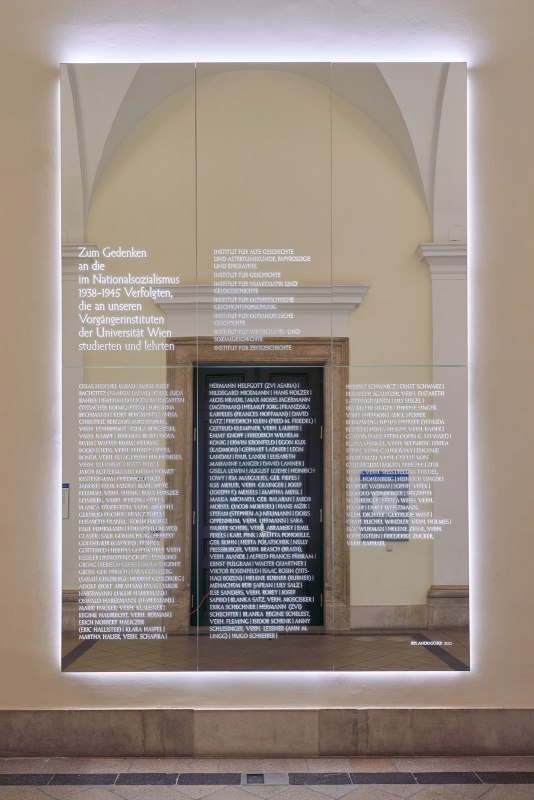
Monument to History Students and Teachers Expelled under National Socialism (“When Names Shine”, Iris Andraschek, 2022)
Monument to History Students and Teachers Expelled under National Socialism ("When Names Shine", Iris Andraschek, 2022)
-
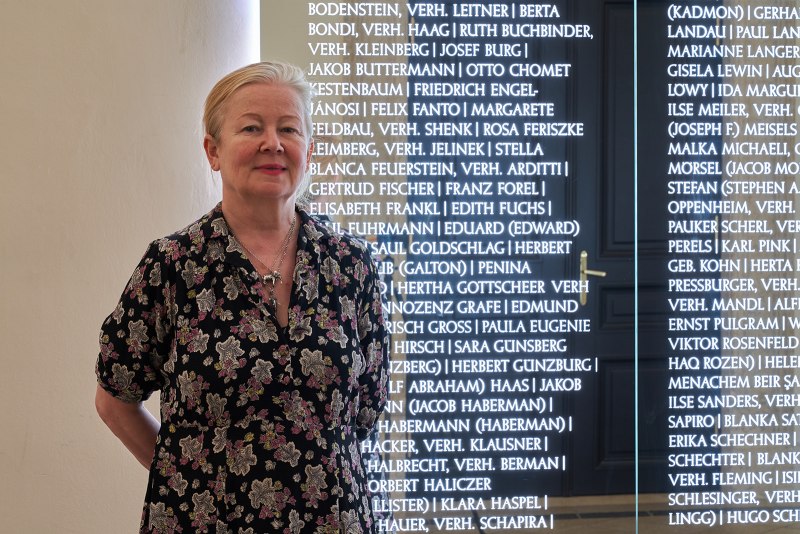
Iris Andraschek vor dem von ihr konzipierten „Wenn Namen leuchten“, Denkmal für die im Nationalsozialismus vertriebenen Geschichte-Studierenden und -Lehrenden, 2022
Künstlerin Iris Andraschek vor "Wenn Namen leuchten", Denkmal für im Nationalsozialismus von der Universität Wien vertriebenen Geschichte-...
-
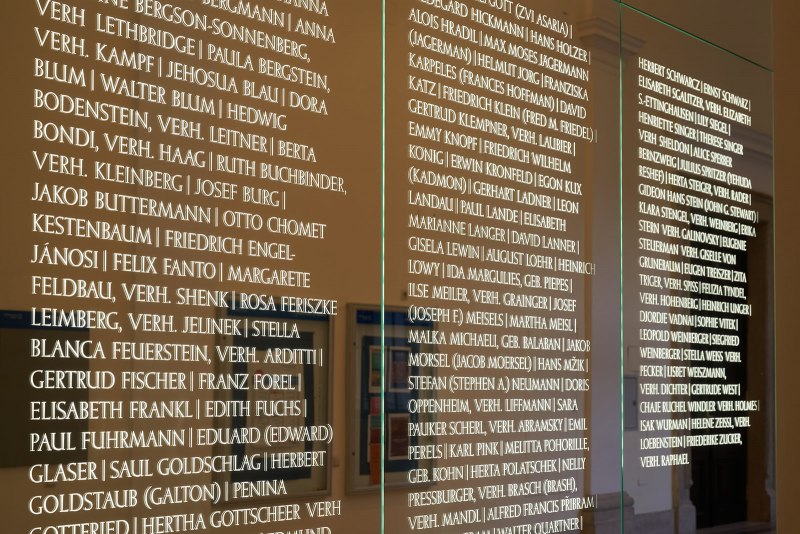
Denkmal für die im Nationalsozialismus vertriebenen Geschichte-Studierenden und -Lehrenden („Wenn Namen leuchten“, Iris Andraschek, 2022)
Denkmal für die im Nationalsozialismus vertriebenen Geschichte-Studierenden und -Lehrenden der Universität Wien ("Wenn Namen leuchten", Iris...
-

Denkmal für die im Nationalsozialismus vertriebenen Geschichte-Studierenden und -Lehrenden („Wenn Namen leuchten“, Iris Andraschek, 2022)
Denkmal für die im Nationalsozialismus vertriebenen Geschichte-Studierenden und -Lehrenden der Universität Wien ("Wenn Namen leuchten", Iris...
-

Denkmal für die im Nationalsozialismus vertriebenen Geschichte-Studierenden und -Lehrenden („Wenn Namen leuchten“, Iris Andraschek, 2022)
Denkmal für die im Nationalsozialismus vertriebenen Geschichte-Studierenden und -Lehrenden der Universität Wien ("Wenn Namen leuchten", Iris...
-

Denkmal für die im Nationalsozialismus vertriebenen Geschichte-Studierenden und -Lehrenden („Wenn Namen leuchten“, Iris Andraschek, 2022)
Eröffnung von "Wenn Namen leuchten", Denkmal für im Nationalsozialismus von der Universität Wien vertriebenen Geschichte-Studierenden und -Lehrenden...
Zuletzt aktualisiert am : 17.04.2024 - 21:31
-
Denkmal für Ausgegrenzte, Emigrierte und Ermordete des Kunsthistorischen Instituts der Universität Wien
2008–21. Jhdt. -
Gedenknischen in der Aula der Universität Wien
2005–21. Jhdt. -
„Tabula rasa? Gedächtnis und Tafel – was bleibt?“
13th.3.2018–21. Jhdt.

